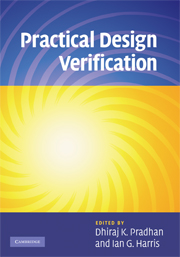Book contents
- Frontmatter
- Contents
- List of contributors
- 1 Model checking and equivalence checking
- 2 Transaction-level system modeling
- 3 Response checkers, monitors, and assertions
- 4 System debugging strategies
- 5 Test generation and coverage metrics
- 6 SystemVerilog and Vera in a verification flow
- 7 Decision diagrams for verification
- 8 Boolean satisfiability and EDA applications
- Index
1 - Model checking and equivalence checking
Published online by Cambridge University Press: 05 August 2012
- Frontmatter
- Contents
- List of contributors
- 1 Model checking and equivalence checking
- 2 Transaction-level system modeling
- 3 Response checkers, monitors, and assertions
- 4 System debugging strategies
- 5 Test generation and coverage metrics
- 6 SystemVerilog and Vera in a verification flow
- 7 Decision diagrams for verification
- 8 Boolean satisfiability and EDA applications
- Index
Summary
Introduction
Owing to the advances in semiconductor technology, a large and complex system that has a wide variety of functionalities has been integrated on a single chip. It is called system-on-a-chip (SoC) or system LSI, since all of the components in an electronics system are built on a single chip. Designs of SoCs are highly complicated and require many manpower-consuming processes. As a result, it has become increasingly difficult to identify all the design bugs in such a large and complex system before the chips are fabricated. In current designs, the verification time to check whether or not a design is correct can take 80 percent or more of the overall design time. Therefore, the development of verification techniques in each level of abstraction is indispensable.
Logic simulation is a widely used technique for the verification of a design. It simulates the output values for given input patterns. However, because the quality of simulation results deeply depends on given input patterns, there is a possibility that there exist design bugs that cannot be identified during logic simulation. Because the number of required input patterns is exponentially increased when the size of a design is increased, it is clearly impossible to verify the overall design completely by logic simulation. To solve this problem, the development of formal verification techniques is essential. In formal verification, specification and design are translated into mathematical models. Formal verification techniques verify a design by proving its correctness with mathematical reasoning, and, therefore, they can verify the overall design exhaustively.
Information
- Type
- Chapter
- Information
- Practical Design Verification , pp. 1 - 50Publisher: Cambridge University PressPrint publication year: 2009
Accessibility standard: Unknown
Why this information is here
This section outlines the accessibility features of this content - including support for screen readers, full keyboard navigation and high-contrast display options. This may not be relevant for you.Accessibility Information
- 1
- Cited by
